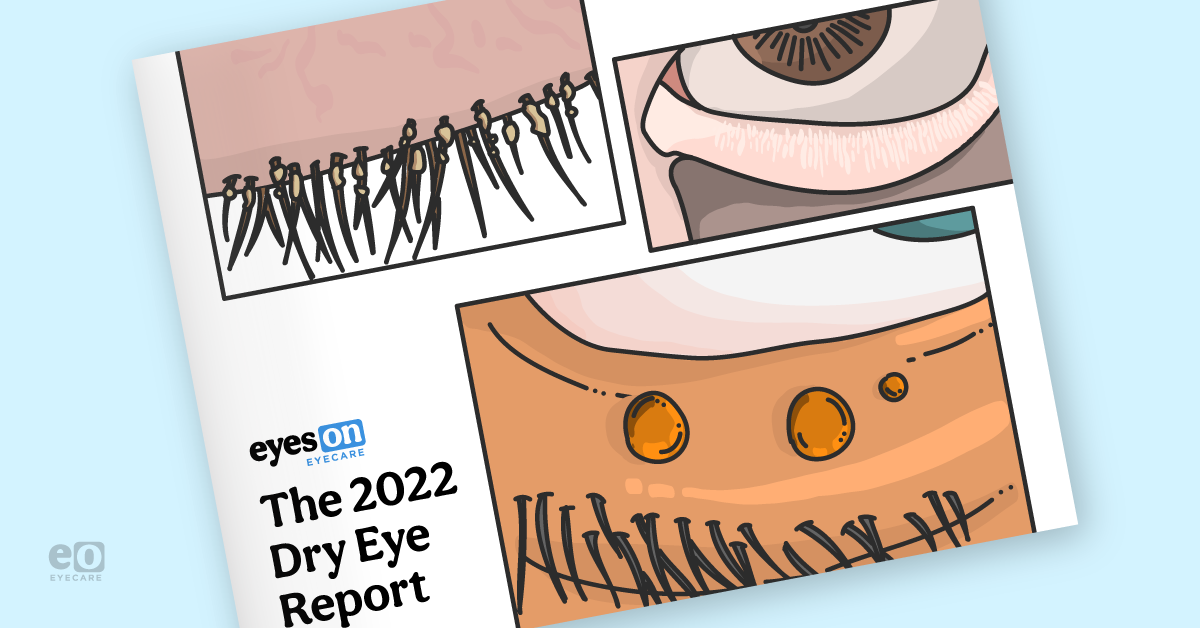Dry Eye Disease (DED) is more prevalent than ever, with an estimated 35 million people in the United States suffering from this disease (1). The prevalence increases each year, with many practitioners suggesting that the ongoing global pandemic coupled with an aging population are significant factors in this growth.
In January of 2022, the Eyes On Eyecare team surveyed 540 eyecare professionals in North America, including 450 practicing optometrists. We sought to understand their approaches to the diagnosis, treatment, and management of dry eye. The result of this survey is the 2022 Dry Eye Report—and as with all Eyes On Eyecare reports, it is absolutely free to download, as we believe that empowering ECPs with data will help them help patients!
Download the 2022 Dry Eye Report now, or keep reading for a sneak peek at the findings!
Learn how ECPs are approaching Dry Eye Disease!
Download the free report to get over 15 pages of charts and graphs about DED diagnosis, treatment, and management.
JUST RELEASED: The 2025 Dry Eye Report
Get insights from hundreds of optometrists in the highly-anticipated 2025 Dry Eye Report! Explore trends, treatments, tools, and advice to help you stay ahead in dry eye management, all for FREE! Click here to download!
The 2022 Dry Eye Report covers:
- Screening and diagnosis: How many ODs utilize validated dry eye questionnaires in their patient intake? How do ODs identify Dry Eye Disease patients?
- Treatment and management of eye dryness and Dry Eye Disease: How do ODs classify their approach to Dry Eye Disease management? What are their go-to treatments for each type of dry eye? What new and cutting-edge treatments are ODs looking to incorporate into their practice?
- Average confidence in treating dry eye: How comfortable are eyecare physicians in treating this increasingly prevalent condition?
- Practice services: How many optometrists are expanding or thinking of expanding their dry eye services? What is the financial impact of adding dry eye services to your practice?
- Advice from fellow optometrists: Throughout the report, you’ll find tips and actionable advice from dry eye specialists and practicing optometrists on where to start with dry eye and how to grow your practice.
- And more!
Optometrist confidence in diagnosis and treatment remains high
Confidence in diagnosing and treating dry eye has dipped slightly but remains high, with 2022 averages at 7.9 for confidence in diagnosis and 7.54 for confidence in treatment.
This dip may seem a bit concerning! However, when you look more closely, two things become immediately clear: First, the dips in confidence are by a few percentage points, which means we really need to have at least one more point of comparison before drawing any major conclusions. Second, we’re still in the middle of an ongoing pandemic. While we didn’t ask any specific questions about burnout or mental health topics unrelated to dry eye, it’s important to acknowledge how our current state and environment impacts more than just our patients’ eyes (2).
That’s not to say that this data can be dismissed; rather, think of it more as a call to action. Education, support, and community are more important than ever. As a disease, DED can seem minor to some, but once you start learning about it, you realize that not only can the disease majorly impact one’s quality of life—but, small actions on the part of eyecare practitioners can effect enormous changes.
Dry Eye Disease treatments are changing
While over-the-counter topical treatments are remaining the go-to approach, we’re seeing a growth in prescription-based treatments as well as in-office treatments, which grew from 5.8% in 2021 to 7.56% in 2022. Prescription-based treatments such as topical steroids grew even more dramatically, jumping from .9% in 2021 to 9.1% in 2022.
There’s also a growing awareness among ODs who don’t treat dry eye themselves that they have colleagues who are set up to support them.
Meanwhile, over in the specific etiologies, topical steroids and topical immunomodulators are now nearly balanced as the treatments of choice for inflammatory dry eye. (It will be worth seeing how the recent
approval of the first generic of Restasis will affect this change.)
While most doctors are still more comfortable prescribing Level 1 therapies (i.e., lid hygiene, environment modification, and artificial tears), optometrists are becoming more confident in recommending higher-level treatments. This is crucial for both patients and doctors: it’s a rare patient whose dry eye can be successfully treated with only one type of therapy. Having access to—and confidence with—a variety of tools will improve not just your patient’s health, but that of your practice.
Optometrists are looking to expand their OSD lines of service
As optometrists grow in confidence, they start to look at how they can expand. Doctors looking to expand their OSD lines of service either immediately, or in the next few years, had higher than average confidence in their ability to diagnose, determine the underlying etiology of, and treat dry eye.
As optometrists continue to shift to more medically focused models and look to increase their dry eye services, we hope that this report will offer key insights for doctors seeking to grow their efforts in this space.
References
- Dana R, Bradley JL, Guerin A, Pivneva I, Stillman I et al. (2019) Estimated Prevalence and Incidence of Dry Eye Disease Based on Coding Analysis of a Large, All-age United States Health Care System. Am J Ophthalmol 202 47-54.
- Wan, K, Chen, L, Young, A. (2016) Depression and anxiety in dry eye disease: a systematic review and meta-analysis. Eye 30, 1558–1567.
There are many different kinds of artificial tears on the market for mild to severe dry eye. Laura Goldberg, OD/MS discusses the different types of artificial tears and shares her insights with a comparative list of the artificial tears on the market with a handy download. Click here to view the list.


